|
|
|
Sort Order |
|
|
|
Items / Page
|
|
|
|
|
|
|
| Srl | Item |
| 1 |
ID:
105672
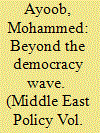

|
|
|
| 2 |
ID:
156108
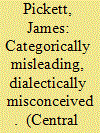

|
|
|
|
|
| Summary/Abstract |
Persian language manuals uniformly adopt national categories such as Persian/Farsi (Iran), Dari (Afghanistan) and Tajik (Tajikistan). These categories at once impose an imagined contrast between the languages at the high register that is in fact marginal, while occluding profound linguistic variation within these nation-states at colloquial registers. Similar schemas apply to Central Asian Turkic languages such as Uyghur and Uzbek, which are closely related at the formal/literary register, but regionally diverse at lower registers. This dominant instructional approach ill prepares language learners for engaging the region on its own terms, rather than through the lens of nationalist aspirations. Students would be better served by an integrative method that teaches a transnational high language (in the case of Persian) while introducing a diverse range of dialects.
|
|
|
|
|
|
|
|
|
|
|
|
|
|
|
|
| 3 |
ID:
106157
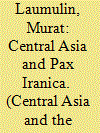

|
|
|
| 4 |
ID:
143589
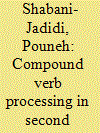

|
|
|
|
|
| Summary/Abstract |
This study investigates compound verb processing in second language speakers (L2) of Persian. Forty-six near-native L2 speakers of Persian were tested to examine the processing of transparent (non-idiomatic) and opaque (idiomatic) compound verbs, under masked priming paradigm. The results revealed a significant nominal priming effect in the opaque condition, and a numerically stronger nominal priming effect in the transparent condition. There was also an increase in the processing load on the parser when the target was an opaque compound. The results of this study seem to be compatible with the dual access or dual route hypothesis, yet with the version that assumes the two routes are activated in parallel rather than the version that assumes high frequency words are represented lexically but low frequency words are decomposed.
|
|
|
|
|
|
|
|
|
|
|
|
|
|
|
|
| 5 |
ID:
180675
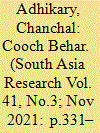

|
|
|
|
|
| Summary/Abstract |
For constructing the medieval political history of Cooch Behar, also known as Koch Bihar, the Persian manuscript of BahÂristÂn-i-Ghaybī, discovered in 1919 by Jadunath Sarkar in the Bibliothèque Nationale of Paris, is very significant. This text facilitates our understanding of important historical events in eastern India during the time of Mughal Emperor Jahangir (1601–27). The text also provides important details of peasants’ revolts during the Mughal occupation, with remarkable implications until recent times regarding border relations between India and Bangladesh. The article examines the historical facts presented in this important text and corroborates them with other sources to argue that this text should be read as a chronicle for the history of warfare, society and peasants’ life in the region throughout the seventeenth century, with significant implications for later historical developments in Cooch Behar.
|
|
|
|
|
|
|
|
|
|
|
|
|
|
|
|
| 6 |
ID:
144713
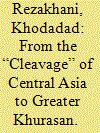

|
|
|
|
|
| Summary/Abstract |
The history of Central Asia is normally considered peripheral to those of the civilizations that surrounded it—Marshal Hodgson termed it a civilizational “cleavage.” However, in the early Islamic period this region, particularly its southern and western parts, emerges as the dominant entity of Greater Khurasan to play a central role in the affairs of the Islamic Caliphate. This paper considers the history of the region, dubbed East Iran, before this rise to importance and proposes a different historiographical approach focusing on the developments in East Iran during the period of late antiquity and in interaction with the Sasanian Empire. It is proposed that the Greater Khurasan emerged as the result of the merging of the socio-cultural worlds of East Iran and that of the Sasanian Empire.
|
|
|
|
|
|
|
|
|
|
|
|
|
|
|
|
| 7 |
ID:
059478
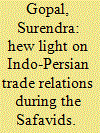

|
|
|
| 8 |
ID:
085336
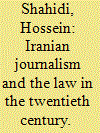

|
|
|
|
|
| Publication |
2008.
|
| Summary/Abstract |
Although the first Persian language newspaper was published in Iran 170 years ago, Iranian journalism is a twentieth century creation, indeed a product of the 1906 Constitutional Revolution. The press played a significant part in the revolution, especially by promoting the demand for the rule of laws enacted by parliament, rather than decrees issued by the king or the religious leaders. Once a constitution had been declared, many journalists felt relieved of all restrictions and engaged in bitter, personal attacks on their opponents, including the monarch and his family. Many papers also opposed a press law that was passed soon after the revolution, arguing that it was meant to suppress their newly-gained freedom. Five more press laws have been passed in Iran since then, but the debate over press freedom and the rule of law in the country does not appear to be anywhere near resolution.
|
|
|
|
|
|
|
|
|
|
|
|
|
|
|
|
| 9 |
ID:
112161
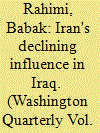

|
|
|
| 10 |
ID:
184811
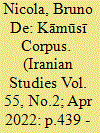

|
|
|
|
|
| Summary/Abstract |
The arrival of the Mongols in Iran in the thirteenth century made a deep impact on the political, economic, and religious life of the region. With the establishment of the Ilkhanate (1250–1335), the cultural life of Iran was also transformed. The territories under Mongol control saw the appearance of new architectural styles, a renaissance of Persian literature, and a burst in the production of Islamic manuscripts. Regarding this literary production, scholars have concentrated their efforts on studying important works composed in Mongol Iran either for their scientific, literary, or artistic value. However, most of this research focuses on individual manuscripts or specific works belonging to a concrete literary genre; these do not provide a holistic picture of the production, distribution, and consumption of the huge number of manuscripts surviving from the period. In an attempt to contribute to a more comprehensive understanding of this phenomenon, this study looks at six different manuscripts, jointly referred to as the “Kāmūsī corpus,” that share the rare characteristic of having all been copied by the same hand in fourteenth-century Iran. This article investigates the individuals involved in the production of these manuscripts, identifies the different works included in this corpus, and connects the production of these texts and the dissemination of knowledge in Ilkhanid Iran.
|
|
|
|
|
|
|
|
|
|
|
|
|
|
|
|
| 11 |
ID:
101289


|
|
|
|
|
| Publication |
2010.
|
| Summary/Abstract |
The two decades, 1925-45, witnessed a dramatic transformation and revitalization of the Persian carpet industry in response to developments in Iranian governance, society and economy. Two historical watersheds were covered by that period, notably the replacement of the Qajar dynasty by a modernizing administration under Reza Shah Pahlavi, and the subsequent wartime occupation of Iran jointly by the Soviet Union and Great Britain. It was during those two decades that Iran acquired a centralized system of government and the beginnings of a modern industrial base. The accompanying social transformation brought about the emergence of new classes of administrators and managers who constituted the dominant elite of the Reza Shah era. This twin process of centralization and modernization had a telling impact on Iranian culture and the arts, including the carpet arts.
|
|
|
|
|
|
|
|
|
|
|
|
|
|
|
|
| 12 |
ID:
101023
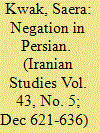

|
|
|
|
|
| Publication |
2010.
|
| Summary/Abstract |
This paper classifies Persian negative elements and analyzes the negative structures based on Minimalism and Distributed Morphology. Negative Polarity Items (NPIs) in Persian which have [-neg] check its feature against [+neg] of negative marker for convergence. Negative Concord Items (NCIs), which are inherently negative, have [+neg]. Thus, in the NC Sentences, we have two [+neg]-one in negative marker, and the other in NCI. It can be misread that a NC structure, like Double Negation, delivers an affirmative reading. To prevent the misreading, we assumed Neg-absorption and Neg-criterion. However, that is impossible in Double Negation with two negative markers placed in different NegP, so the [+neg] in the sentence remain till Logical Form (LF) and they cancel each other and, as a result, the sentence becomes affirmative. Based on Minimalism and Distributed Morphology, the unified account on the structure of negation is examined.
|
|
|
|
|
|
|
|
|
|
|
|
|
|
|
|
| 13 |
ID:
103685
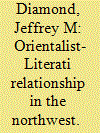

|
|
|
|
|
| Publication |
2011.
|
| Summary/Abstract |
Lahore emerged as a new intellectual centre in northwest India for British Orientalists and Indian intellectuals after the destruction of Delhi during the Great Revolt of 1857. Two prominent individuals who moved to Lahore at this time were Gottlieb Leitner, a philologist and Orientalist scholar, and Maulana Muhammad Hussain Azad, an Urdu poet, literary critic and teacher. Leitner, a naturalised British citizen who studied in Istanbul and completed higher education in Arabic and Turkish in London, became principal of the new Government College in Lahore in 1864. In this position, he exercised a deep influence on education in the northwest by promoting the development and study of vernacular (Urdu language) education, founding and leading a major scientific and literary organisation, the Anjuman-e Punjab. Having aroused strong British opposition, both to his ideas and his combative personality, Leitner's support and assistance from the local literati allowed him to develop and implement his ideas. Leitner's most significant partner was Muhammad Hussain Azad, also a new arrival to Lahore after fleeing Delhi in 1857. Leitner and Azad worked together in the Anjuman-e Punjab to promote their literary and social concerns. They became advocates of neo-Orientalist educational reforms through their public speeches and writing, including works in Urdu intended for, among others, the education of Maulvis. The bracketing of these European and Indian partners is conceptualised in this article through their roles as members of their respective communities as well as outsiders to these very communities. The analysis shows how their complex identities helped them to become highly influential figures in the new cultural environment of post-1857 Lahore.
|
|
|
|
|
|
|
|
|
|
|
|
|
|
|
|
| 14 |
ID:
168625
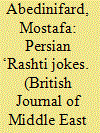

|
|
|
|
|
| Summary/Abstract |
For almost a century, a Persian ethnic joke cycle has circulated among Iranians about the men and women of the northern Iranian city of Rasht, labelling them as cuckolds and promiscuous women. A foray into the historical background and possible (gendered) functions of these jokes is long overdue. I argue that the central motif of Rashti jokes is gheyrat—a gendered social construct based on a man’s sense of honour, possessiveness and protectiveness towards certain female kin—which remains pivotal to our understanding of the texts and the historical context of the jokes. Critically reviewing extant theories on the historical origins of Rashti jokes, I argue they have roots in two modern phenomena: (a) debates among turn-of-the-twentieth-century Iranian thinkers over women’s (un)veiling; and (b) Reza Shah’s methodical promotion of an Aryanist, pan-Persian ideology. Focusing on the gender-disciplinary functions of the jokes, I then show how some contemporary Rashti jokes are deployed to project and inscribe gender-hierarchical notions that clearly surpass the jokes’ immediate, ethnic targets by commenting on broad socio-political topics. Such instances suggest that as a culture-wide joke cycle, Rashti jokes may also reinforce a form of Iranian masculinity obsessed with gheyrat-motivated control and aggression.
|
|
|
|
|
|
|
|
|
|
|
|
|
|
|
|
| 15 |
ID:
144721
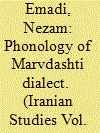

|
|
|
|
|
| Summary/Abstract |
Phonology is one of several aspects of a natural language and it is the study of sound systems of languages. The purpose of this article is to study and describe the phonemic system of the dialect of Marvdashti. Marvdashti dialect belongs to the southwestern branch of New Iranian languages. The article deals with an inventory of Marvdashti dialect sounds and their features and it covers the phonological rules which specify how sounds interact with each other. This study first introduces and examines the consonants and vowels of Marvdashti dialect, and then explores phoneme arrangement, syllable structure and phonological processes such as assimilation, dissimilation, alteration, epenthesis, deletion and methathesis.
|
|
|
|
|
|
|
|
|
|
|
|
|
|
|
|
| 16 |
ID:
128569
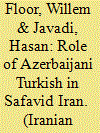

|
|
|
|
|
| Publication |
2013.
|
| Summary/Abstract |
Turkic languages and dialects played a much more important role in Safavid Iran than is generally thought, while Azerbaijani Turkish in particular was widely spoken and written in Safavid Iran. It was not only the language of the court and the army, but it was also used in poetry, even by renowned poets who usually wrote in Persian. The Safavid shahs, many of whom wrote poetry in Turkish themselves, promoted its literary use. Also, Turkish was used in the court's official correspondence, for both internal and external affairs.
|
|
|
|
|
|
|
|
|
|
|
|
|
|
|
|
| 17 |
ID:
154346
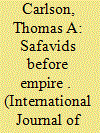

|
|
|
|
|
| Summary/Abstract |
Armenian sources from the 15th century provide distinctive viewpoints on the history of the Safaviyyih Sufi order before the foundation of the Safavid Empire. The history of T‘ovma of Metsop‘ suggests an earlier intermediate step in the militarization of the order, which scholars have typically viewed as an unprecedented development beginning after 1447, and ascribes to the Safavi shaykh the idea of taxing non-Muslims to encourage conversion to Islam. A second Armenian text, a previously unknown colophon, describes Haydar's attack on Shirvan in 1488 and the suffering of the Muslim and Christian sedentary population, as well as an episode of interreligious mockery. It is probably the earliest extant source to identify the Qizilbash by their distinctive red hats. Together, these sources suggest ways in which the Safaviyyih order's development was conditioned by the multireligious environment. They are examples of the value of non-Muslim sources even for late medieval Islamic history.
|
|
|
|
|
|
|
|
|
|
|
|
|
|
|
|
| 18 |
ID:
101025
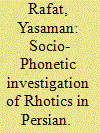

|
|
|
| 19 |
ID:
084941
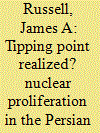

|
|
|
|
|
| Publication |
2008.
|
| Summary/Abstract |
The Persian Gulf and the wider Middle East are precariously perched on an uncertain nuclear threshold. Several regional states may be reconsidering their non-nuclear status. Iran's confrontation with the international community over its refusal to honour its obligations under the Nuclear Non-Proliferation Treaty is the overriding component states are viewing. Another element is Israel's nuclear program and its policy of preventing any regional state from threatening the Jewish state with nuclear weapons. Another complicating element in the strategic framework is a resurgent interest in nuclear energy.
What is the security policy community to make of these dynamics in which proliferation, deterrence, extended deterrence, and conflict escalation are all interacting in a complex interstate bargaining framework? This article applies a series of competing theoretical explanations for nuclear proliferation and assesses the implications they offer for policy prescriptions. Stressing neo-realist insights, it is shown here that control of proliferation requires recognition that the Middle East security dilemma has been altered - probably permanently - by the American invasion of Iraq, the increased political influence of Iran, and the continued violent spiral in the Arab-Israeli dispute. These three factors have combined to create new internal political pressures on regional regimes while at the same time creating a new and disturbing regional distribution of power that is shaping the region's approach to nuclear issues. Dealing with these factors is crucial in developing policies that can mitigate the further spread of nuclear weapons in the region.
|
|
|
|
|
|
|
|
|
|
|
|
|
|
|
|
| 20 |
ID:
177049
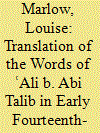

|
|
|
|
|
| Summary/Abstract |
The late Ilkhanid period saw a florescence of intellectual and cultural production in northwestern and west-central Iran. This article argues that a regional network with its center at Isfahan contributed to this creativity through the production of translation-adaptations between Arabic and Persian. In a period of episodic sectarian tensions, especially in the wake of Öljeytü’s efforts to declare Twelver Shiʿism the official religion of parts of ʿIraq-e ʿAjam, this local network produced a set of five bilingual treatments of parts of the literary legacy of ʿAli b. Abi Tālib (d. 40/661). The article argues that the authors and copyists of these texts sought, through their focus on the figure of ʿAli and their exploration of the ambiguities facilitated by bilingual composition, to expand a non-sectarian middle-ground.
|
|
|
|
|
|
|
|
|
|
|
|
|
|
|
|
|
|
|
|
|